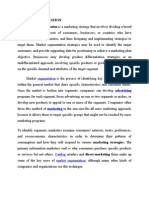Production Orientation
Production Orientation
Uploaded by
podderCopyright:
Available Formats
Production Orientation
Production Orientation
Uploaded by
podderOriginal Description:
Copyright
Available Formats
Share this document
Did you find this document useful?
Is this content inappropriate?
Copyright:
Available Formats
Production Orientation
Production Orientation
Uploaded by
podderCopyright:
Available Formats
Production Orientation In the production era, the production orientation dominated business philosophy.
Indeed business success was often defined solely in terms of production victories. The focus was on production and distribution efficiency. The drive to achieve economies of scale was dominant. The goal was to make the product affordable and available to the buyers. In the product era, the goal was to build a better mouse trap and it was assumed that buyers will flock the seller who does it. However, a better mousetrap is no guarantee of success and marketing history is full of miserable failures despite better mousetrap designs. Inventing the greatest new product is not enough. That product must also solve a perceived marketplace need. Otherwise, even the best-engineered. Highest quality product will fail. In the sales era, firms attempted to match t heir output to the potential number of customers who would want it. Firms assumed that customers will resist purchasing goods and services not deemed essential and that the task of selling and advertising is to convince them to buy. But selling is only one component of marketing. Next came the marketing era during which the company focus shifted from products and sales to customers needs. The marketing concept, a crucial change in management philosophy, can be explained best by the shift from a sellers market one with a shortage of goods and services to a buyers market one with an abundance of goods and services. The advent of a strong buyers market created the need for a customer This orientation. Companies had to market goods and services, not just produce them.
realization has been identified as the emergence of the marketing concept. The keyword is customer orientation. All facets of the organization must contribute first to assessing and then to satisfying customer needs and wants. The relationship marketing era is a more recent one. Organizations carried the marketing eras customer orientation one step further by focusing on establishing and maintaining relationships with both customers and suppliers. This effort represented a major shift from the traditional concept of marketing as a simple exchange between buyer and seller. Relationship marketing, by contrast, involves long-term, value-added relationships developed over time with customers and suppliers. The following table summarizes the differences between transaction marketing (i.e. exchanges characterized by limited communications and little or no ongoing relationship between the parties) and relationship marketing. 1.4 Nature of Marketing The term marketing concept holds that achieving organizational goals depends on knowing the needs and wants of target markets and delivering the desired satisfactions. It proposes that in order to satisfy its organizational objectives, an organization should anticipate the
needs and wants of consumers and satisfy these more effectively than competitors. The spirit of market is exchange of products and service to satisfy human needs, wants, demand, utility etc. Marketing is used to identify the customer, satisfy the customer, and keep the customer. With the customer as the focus of its activities, marketing management is one of the major components of business management. The several scope of marketing are summarized as follows: 1. Marketing enables to increase the profit. 2. It increases the Per capita and National Income. 3. It improves the standard of living of the people. 4. It satisfies the needs of the people by providing the goods to the Customers. 5. It improves transport and communications. 6. It establishes a better relationship between the buyer and the seller. 7. It achieves economic stability. 8. It makes goods available to all geographic locations. 9. It increases revenue to the government. 10. It helps in creation of utilization. 11. It helps the manufacturer to decide what to produce, when to produce and how to sell a product or service . 12. It enables the firm to meet the demands of various classes of consumers thereby increase the sales. Helpful in Business Planning and decision making: Marketing is helpful not only to plan the production but it is also helpful in business planning and in taking various decisions regarding the business. In todays economy, production is planned according to the sales forecasts and not according to the production capacity of the firm. A firm will produce what it can sell or as much quantity as it can sell and not what and how much it can produce. Thus marketing decisions affect the business decisions. All other activities such as planning, production, purchase, finance revolve around the marketing decisions. (ii) Helpful in Increasing Profits: Every business is carried on with the profit motive. Marketing helps in increasing the business profits by reducing the selling cost on one hand and by increasing the demand of the product through advertising and sales promotion activities on the other hand. (iii) Helpful in Communication between Firm and Society : Business collects various information regarding consumers behaviour and the changes in their behaviours from time to time through marketing. Marketing also provides information to the firm about the competitors, price, policies and distribution policies. Marketing provides extensive information of the product regarding its quality, price, utility and place of availability to the society. Thus, society comes to know about the new products 2. Importance of Marketing to Society (i) Delivery of Standard of Living: The main object of marketing is to provide goods and services to the people in the society to their satisfy needs and wants at reasonable price. It is to satisfy the wants of people by the discovery of needs of the society, produceing goods and services accordingly, thereby creating demand for these goods, encourage people to use them and those by improve the standard of living of the people. Thus marketing creates, maintains and increases the demand of new and existing products and thus raises the standard of living of the people.
(ii) Provides Employment: According to an estimate, 40 percent of the labor force in developed economies (USA, Germany, and Japan Etc) is engaged in different marketing processes such as marketing research work, wholesale and retail business, transport, communications, storing, warehousing, publicity work etc. In underdeveloped economies like, India, there is a great scope for increasing opportunities for employment by developing marketing processes. (iii) Decreases in Distribution Cost: Marketing aims at reducing the cost of distribution as far as possible so that the commodities might be within the reach of maximum number of consumers. It increases the level of consumption in the society. Reduction in the cost of distribution directly affects the price of the commodity and it will also be reduced. As a result, the product can now be purchased by customers who were unable to purchase it due to high prices. Even if, we assume that the price is not reduced, it will increase the profits of the producer, which will filter down to the shareholders. A part of the profit may also be utilized for further research work. Thus indirectly the society is benefited in the long run. (iv) Increase in National Income: Sound marketing system is associated with creation of increased demand for goods and services. An increased demand stimulates production activity in the country which in turn increases the national income which is in the interest of the whole economy. 3. Importance of marketing in Underdeveloped/Developing Economy Marketing has a special significance in underdeveloped economies. A rapid development of the economy is possible only by adopting the modern methods of marketing. Marketing in underdeveloped economies is still in its infancy. Industrialisation and organization goes hand in hand with application of modern refinements in the field of marketing. An effective marketing system alone can bring the fruits of production to the people. India provides the best example in this connection one of the causes for recession is actually the result of recollecting the development of marketing. Marketing and an effective engine of development. At mobilizes latent economic energy and thus is the creator of small business. Thus, the concept of marketing in underdeveloped economies has to go a long way to catch up with the requirements of rapid industrial growth. 4. Importance of marketing in Developed Economy The economy of abundance is indicated by the way of life itself, which connotes a certain degree of development in marketing. In such countries the volume of production with all its up-to-date technology is generally more than the demand. In order to maintain the level of production it is absolutely necessary that the produced amount is disposed off readily in the country itself or abroad on the basis of non price competition. This is possible only by a very sound and advanced marketing system because of still competition in the market. 5. Importance Of marketing in a seller or Buyers market A sellers market is one in which the demand for goods and services exceeds the supply. In such a situation there is tendency of growing monopolies. On the other hand buyers market is one in which the supply of goods exceeds the demand. Every firm is eager to sell its goods but only that the firm succeeds which adopts the scientific ways of marketing of goods, which means adopting the designs and quality of goods in accordance with the changing tastes and likings of the common consumers. Thus the importance of marketing in both the sellers and the buyers market is great indeed. 1.7 Approaches to Study of Marketing and Economic Development 1. Commodity Approach
This approach studies marketing on commodity basis. The marketing situation of each product is studied with regards to its sources of supply, marketing organization and policies, involvement of the middlemen, to the extent of the market. This approach is also called as Descriptive Approach. In this method the commodity serves as a focus, around which other aspects of marketing are studied and its journey from the original producer right up to the final customer. In this we can locate the centre of production. People engage in buying and selling of the product, mode of temptation and so on. Through such an approach we can find out the difference in marketing products, services and problems. Thus we get a clear picture of marketing of agricultural products such as cotton, wheat, jute represents the commodity approach. In this approach the subject matter of the discussion is centered around the specific commodity selected for the study and include the source and conditions of supply, nature and extent of demand, distribution channels used and functions such as buying, selling , financing, advertising and storage performed by various agencies. By repeating such studies these now be increase of different commodities, one gets a complete picture of the entire field of marketing its main defect is that it is repetitive and time consuming. 2. Institutional Approach In this method description and analysis of the different institutions engaged in marketing are undertaken. Here we study not the products but the producers, wholesalers, agents, retailers, transporters, storing institutions etc. Different institutions serve as separate cells of the marketing body. The functions performed by each cell form part of the whole area of marketing and our main interest centers round the marketing institution or agencies such as wholesalers, retailers, transport undertakings, banks, insurance companies etc. In this approach the focus is on the study of various middle men and facilitating agencies. The study includes their position in the distribution channels, the purpose of their existence, the functions performed, their operating methods and service rendered by them. In order to obtain a comprehensive view of marketing the study is related to each type of institutes. 3. Functional Approach This approach splits down the field of marketing into separate functions. These specific functions are buying, selling, transportation, storage, standardization, grading, financing, risk-taking and marketing research, etc. We also concentrate our attention on the specialized service or functions or activates performed by marketers. In the functional approach the focus of studying is on the different kinds of functions necessary to complete the market transportation. Though there is no unanimity about the number and nature of functions that constitutes marketing, some functions after recognition are selling, buying, storage, transportation, promoting etc. In this approach marketing is regarded as: The business of buying and selling and includes those business attributes involved in the flow of goods and services between producers and consumers. These functions are also studied in relation to commodities and marketing institutions, in terms of nature, important operational cause and methods. This approach is definitely an improvement over the former ones but not entirely free from defects.
You might also like
- Customer Relationship Management Project ReportDocument108 pagesCustomer Relationship Management Project Reportmohitalk2me75% (97)
- Retail MarketingDocument16 pagesRetail MarketingShweta ThakurNo ratings yet
- Nedbank Group Financial StatementsDocument132 pagesNedbank Group Financial StatementsNeo NakediNo ratings yet
- Customer Relationship: Customer Service: Principles of MarketingDocument12 pagesCustomer Relationship: Customer Service: Principles of MarketingJade Payba100% (2)
- Test Bank For Business Marketing Management B2B 11th Edition by HuttDocument18 pagesTest Bank For Business Marketing Management B2B 11th Edition by Hutta396799402No ratings yet
- Chapter 5 Product: The Best Way To Hold Customers Is To Constantly Figure Out How To Give Them More or LessDocument59 pagesChapter 5 Product: The Best Way To Hold Customers Is To Constantly Figure Out How To Give Them More or Lessabhay pratap singhNo ratings yet
- Lesson 15 STPDocument24 pagesLesson 15 STPdjokouwm100% (1)
- Customer ProfilingDocument4 pagesCustomer ProfilingNardsdel RiveraNo ratings yet
- Developing Merchandise PlansDocument24 pagesDeveloping Merchandise PlansVenera TuraevaNo ratings yet
- Chapter5 Social Aspect of PersonalityDocument42 pagesChapter5 Social Aspect of PersonalityEvelyn RebuenoNo ratings yet
- Relationship Marketing in Retailing & International RetailingDocument72 pagesRelationship Marketing in Retailing & International Retailingkiran 17mba11No ratings yet
- Market Analysis Segmentation, Targeting and PositioningDocument70 pagesMarket Analysis Segmentation, Targeting and Positioningsamrulezzz100% (1)
- Sales Control SystemDocument11 pagesSales Control SystemAk SinghNo ratings yet
- Entrepreneurial Marketing (Aes 51003) : Prepared For: Prof Madya Noor Hasmini Binti Abd GhaniDocument8 pagesEntrepreneurial Marketing (Aes 51003) : Prepared For: Prof Madya Noor Hasmini Binti Abd GhaniMuhammad Qasim A20D047FNo ratings yet
- PRINCIPLES OF MARKETING 1... NoteDocument27 pagesPRINCIPLES OF MARKETING 1... NoteJohnPaul OnwukaNo ratings yet
- Chapter 1 SummaryDocument15 pagesChapter 1 SummaryIbrahim Tahayna100% (1)
- Chapter - 6 Pillers of Marketing (STPD)Document82 pagesChapter - 6 Pillers of Marketing (STPD)Book wormNo ratings yet
- Pricing of Product PDFDocument17 pagesPricing of Product PDFChinmay LearningNo ratings yet
- TOWS Analysis Is A Variant of The Classic Business ToolDocument6 pagesTOWS Analysis Is A Variant of The Classic Business Toolsyed_murshedNo ratings yet
- Chapter 6 Franchise QDocument20 pagesChapter 6 Franchise QNguyên Bùi100% (1)
- Marketing Chapter 4Document33 pagesMarketing Chapter 4Derrek DullescoNo ratings yet
- Market Segmentation: Naveen Kumar PGFB0925Document18 pagesMarket Segmentation: Naveen Kumar PGFB0925summernaveenNo ratings yet
- WarehousingDocument16 pagesWarehousingSanil MambullyNo ratings yet
- Selling StyleDocument11 pagesSelling StyleAshirbad0% (1)
- 1 HospitalityDocument49 pages1 HospitalityMohammed SalehNo ratings yet
- Market Segmentation: Presented byDocument39 pagesMarket Segmentation: Presented byRupali SainiNo ratings yet
- 2 Personal Selling Process-NotesDocument19 pages2 Personal Selling Process-NotesAshutosh SonkerNo ratings yet
- Revenue Management and Its Application in Front Office: A Presentation By: Tanishk SinghDocument12 pagesRevenue Management and Its Application in Front Office: A Presentation By: Tanishk SinghTanishk SinghNo ratings yet
- Legal Rights of and Privileges of Common StockholdersDocument7 pagesLegal Rights of and Privileges of Common StockholdersedisciaNo ratings yet
- Startegic Brand Management ProcessDocument24 pagesStartegic Brand Management Processtkashvin100% (1)
- Porter's 5 Forces Benchmarking (Porter's Value Chain) Porter's Generic StrategiesDocument38 pagesPorter's 5 Forces Benchmarking (Porter's Value Chain) Porter's Generic StrategiesSandeep Kaur SraNo ratings yet
- Competition in Hotel IndustryDocument16 pagesCompetition in Hotel IndustryMalabica DasNo ratings yet
- The Notion of DominanceDocument8 pagesThe Notion of DominanceHarshit SinghNo ratings yet
- TS-06 Solved Assignment 2023Document15 pagesTS-06 Solved Assignment 2023122 - M BhumishNo ratings yet
- Merchandising MixDocument27 pagesMerchandising MixAeshna SoniNo ratings yet
- VM GuidelinesDocument25 pagesVM Guidelinesprinces280% (1)
- The Financial SystemDocument47 pagesThe Financial SystemAlexa Daphne M. EquisabalNo ratings yet
- Pricing Policies: B) External FactorsDocument10 pagesPricing Policies: B) External FactorspRiNcE DuDhAtRaNo ratings yet
- Combination StrategyDocument5 pagesCombination StrategyNadya ShaminiNo ratings yet
- Product & LineDocument50 pagesProduct & LinePRIYA KUMARINo ratings yet
- Multi Branding StrategyDocument11 pagesMulti Branding Strategysky11100No ratings yet
- Tutorial 1 QADocument1 pageTutorial 1 QACarlo WidjajaNo ratings yet
- Marginal Costing & Break Even Analysis PDFDocument58 pagesMarginal Costing & Break Even Analysis PDFAdarsh SinghNo ratings yet
- Principles of Marketing: Branding & PackagingDocument28 pagesPrinciples of Marketing: Branding & PackagingGhufran AhmedNo ratings yet
- Chapter 8 Product Services and BrandsDocument3 pagesChapter 8 Product Services and BrandsAyesha FatimaNo ratings yet
- Retail Management Unit - Iv: Prepared byDocument47 pagesRetail Management Unit - Iv: Prepared byDaniel JkNo ratings yet
- Fruit PunchDocument25 pagesFruit PunchSalmanNaseerNo ratings yet
- International Monetary and Financial Systems - Chapter-4 MbsDocument62 pagesInternational Monetary and Financial Systems - Chapter-4 MbsArjun Mishra100% (1)
- Stores Layout and DesignDocument19 pagesStores Layout and DesignkrishnakctbaNo ratings yet
- Target MarketDocument3 pagesTarget MarketNiño Rey LopezNo ratings yet
- Promotion Strategy in International ContextDocument14 pagesPromotion Strategy in International ContextSete MengstuNo ratings yet
- Marketing Strategy Target Market Consumers Businesses CountriesDocument9 pagesMarketing Strategy Target Market Consumers Businesses CountriesIbrahim Olasunkanmi AbduLateefNo ratings yet
- Customer Profile TemplateDocument5 pagesCustomer Profile Templatealfaroq_almsryNo ratings yet
- Organizational Behavior PDFDocument72 pagesOrganizational Behavior PDFprabu06051984No ratings yet
- Marketing Segmentation - KotlerDocument23 pagesMarketing Segmentation - KotlerRajiv MondalNo ratings yet
- Final RM AssignmentDocument5 pagesFinal RM AssignmentAkhil DevNo ratings yet
- Consumer Market Segmentation: Prepared By: Jastine EscoteDocument35 pagesConsumer Market Segmentation: Prepared By: Jastine EscoteJohn DelacruzNo ratings yet
- MarketingDocument137 pagesMarketingArushi AwasthiNo ratings yet
- FMCGDocument69 pagesFMCGdipu_vora143No ratings yet
- Principles of MarketingDocument18 pagesPrinciples of MarketingCrismarc FariñasNo ratings yet
- MM Module 1Document45 pagesMM Module 1wordsawwNo ratings yet
- Project On MarketingDocument18 pagesProject On MarketingAshis Kumar MohapatraNo ratings yet
- Introduction About MarketingDocument9 pagesIntroduction About MarketingTeja Choudhary MedarametlaNo ratings yet
- Costing Methods: Cost ConceptsDocument3 pagesCosting Methods: Cost ConceptspodderNo ratings yet
- History of Audit in IndiaDocument4 pagesHistory of Audit in Indiapodder0% (1)
- Continuous Interaction AnalysisDocument8 pagesContinuous Interaction AnalysispodderNo ratings yet
- New Retail FormatDocument3 pagesNew Retail FormatpodderNo ratings yet
- Polynesian Empire LeagueDocument2 pagesPolynesian Empire LeaguepodderNo ratings yet
- Public SectorDocument9 pagesPublic SectorpodderNo ratings yet
- Public SectorDocument9 pagesPublic SectorpodderNo ratings yet
- Services Marketing - Ma.moduleDocument241 pagesServices Marketing - Ma.moduleeldanasime9No ratings yet
- Gummesson2004 Return From Relationship PDFDocument13 pagesGummesson2004 Return From Relationship PDFPhương VõNo ratings yet
- QuestionnaireDocument8 pagesQuestionnaireDavid MukunzaNo ratings yet
- A Review of The Issues Associated With Customer Relationship Management SystemsDocument10 pagesA Review of The Issues Associated With Customer Relationship Management Systemssubhi1980No ratings yet
- Relationship MarketingDocument13 pagesRelationship MarketingHendri KoreNo ratings yet
- Customer Relationship MarketingDocument3 pagesCustomer Relationship MarketingArun SangwanNo ratings yet
- 04 Impact of CRM On Customer Satisfaction and Customer Loyalty - PHD ThesisDocument190 pages04 Impact of CRM On Customer Satisfaction and Customer Loyalty - PHD ThesisWelly MahardhikaNo ratings yet
- 41 - Personal Selling and SalesDocument14 pages41 - Personal Selling and SalesHelen Bala DoctorrNo ratings yet
- Chapter 01 (Introduction To Marketing Part II)Document54 pagesChapter 01 (Introduction To Marketing Part II)Dilshan KularathneNo ratings yet
- Marketing Basics & Fundamentals: Anne Leinovaara-Matomäki Turku University of Applied SciencesDocument74 pagesMarketing Basics & Fundamentals: Anne Leinovaara-Matomäki Turku University of Applied SciencesPekka VirtanenNo ratings yet
- Northern Mindanao Colleges, Inc.: Self-Learning Module For Principles of Marketing Quarter 1, Week 2Document5 pagesNorthern Mindanao Colleges, Inc.: Self-Learning Module For Principles of Marketing Quarter 1, Week 2Yara King-PhrNo ratings yet
- Marketing Solution To Chapter 1 MCQDocument52 pagesMarketing Solution To Chapter 1 MCQangelofsaNo ratings yet
- Relationship MarketingDocument16 pagesRelationship MarketingCarmilleah Freyjah100% (2)
- Vivek Beatty and Morgan JM TP 2012Document21 pagesVivek Beatty and Morgan JM TP 2012fernandus manurungNo ratings yet
- Chap 003Document43 pagesChap 003sarakhan0622No ratings yet
- Role of Social Media Marketing in InfluencingDocument60 pagesRole of Social Media Marketing in InfluencingANKIT SINGH RAWATNo ratings yet
- Final Thesis RinaDocument66 pagesFinal Thesis RinaDNo ratings yet
- Ch.14 - Customer Loyalty and RetentionDocument23 pagesCh.14 - Customer Loyalty and Retentionderbydrive19No ratings yet
- Evolution of MarketingDocument4 pagesEvolution of MarketingGIDEON KATONo ratings yet
- SM PPT CombinedDocument83 pagesSM PPT CombinedVishal ShawNo ratings yet
- Business Buying BehaviourDocument19 pagesBusiness Buying BehaviourKylashD100% (1)
- 11 Brand Engagement and Brand LoyaltyDocument17 pages11 Brand Engagement and Brand LoyaltyLiza NoraNo ratings yet
- ENT 206 Customers Relationship ManagementDocument145 pagesENT 206 Customers Relationship ManagementMarieNo ratings yet
- Direct Marketing 4Document39 pagesDirect Marketing 4International Conference and Research PresentationNo ratings yet
- Marketing Mids Notes by MadKingDocument15 pagesMarketing Mids Notes by MadKingAhmed SaeedNo ratings yet
- BBPM 2203 Pengurusan PemasaranDocument14 pagesBBPM 2203 Pengurusan PemasaranFreshlynero JonalNo ratings yet






























































































